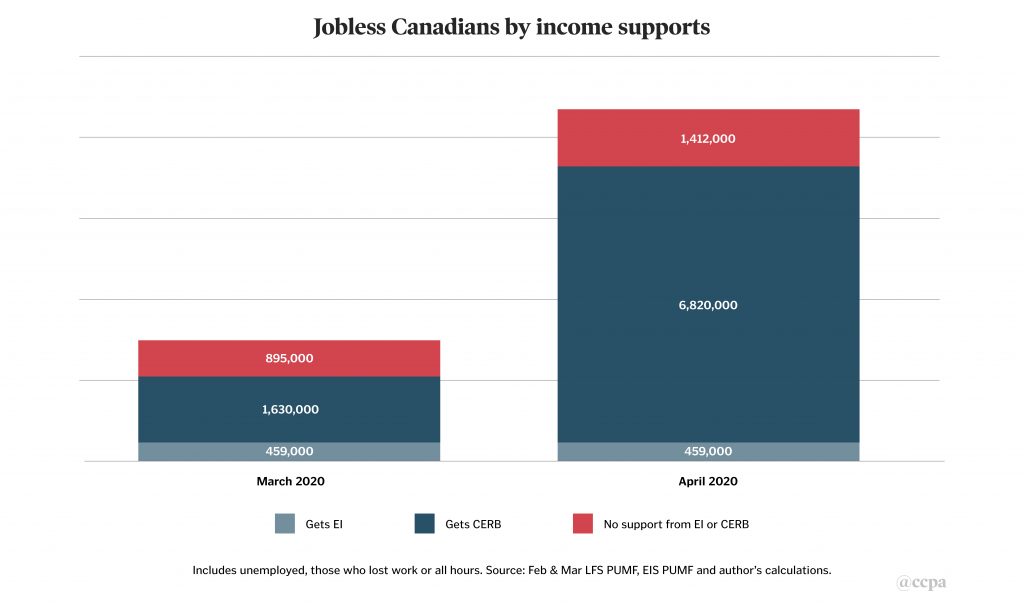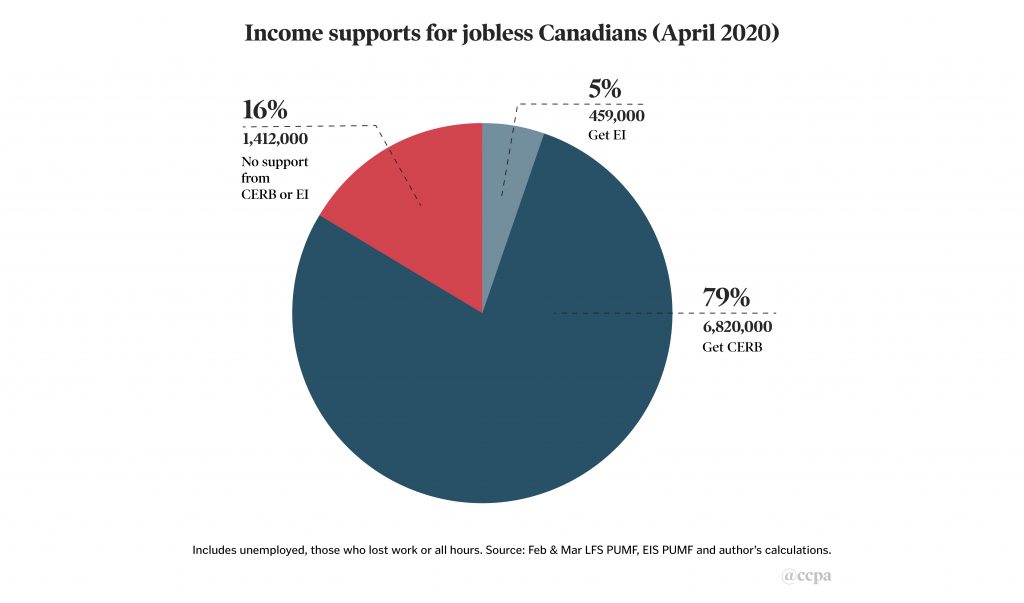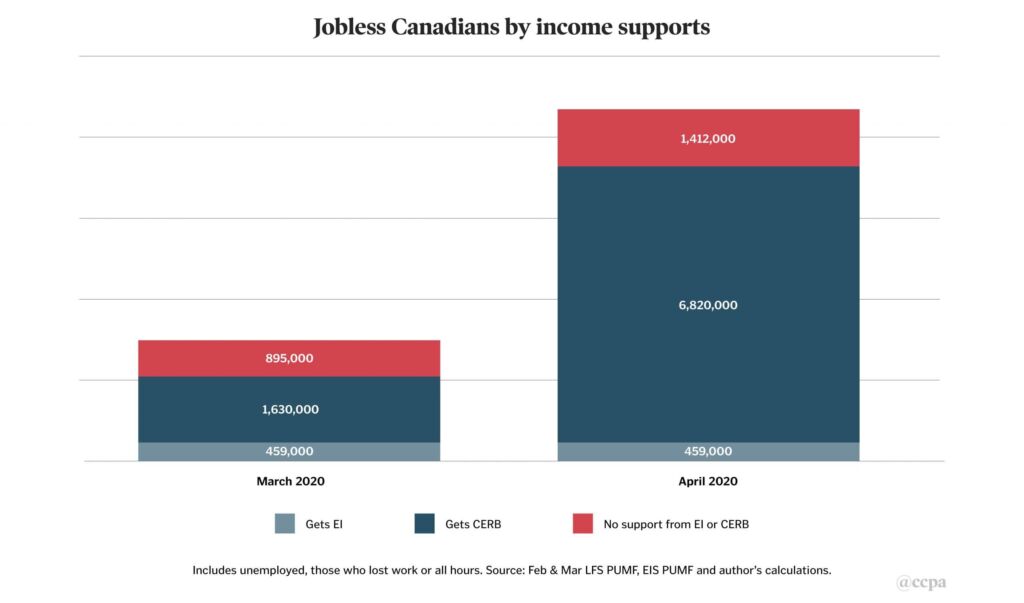Key Findings
Who’s in, who’s out:
- In April there were 1.4 million jobless Canadians without any income support from EI or CERB, up from 895,000 in March.
- 16% of all jobless Canadians had no support in April, down from 30% in March.
- The largest group of excluded workers (549,000) lost work before March 15th; they didn’t qualify for EI and can’t get CERB.
- CERB now allows earnings of up to $1,000/month which gives an additional 904,000 Canadian workers access to the benefit.
- Another 199,000 Canadians who currently make less than $1,000 a month but didn’t make $5,000 last year won’t get CERB.
- There are 1.4 million Canadians who make between $1,000 and $2,000 a month who will likely try to cut their hours so that they earn less than $1,000 to qualify for CERB.
Who’s in and who’s out of federal income supports
Only two weeks ago I estimated that in March 862,000 out-of-work Canadians weren’t getting any income support from the new Canada Emergency Response Benefit (CERB) or from the old Employment Insurance (EI). I now believe that figure is slightly higher at 895,000. Despite important design improvements to the benefit, my estimate of jobless Canadians without support has risen to a staggering 1.4 million or 16% of all jobless Canadians as of the third week in April.
A lot has changed in these past two weeks, the most important of which is the release of the Labour Force Survey (LFS) that allows for much better estimates of exactly who lost their jobs in the third week in March and therefore how eligible they’ll be for support. There have also been several important changes to the emergency benefit itself that moved several groups from no support to CERB-supported, including those whose EI claim expired prior to March 15 (but after Jan 1), those receiving social assistance but working, and those who currently make under $1,000 a month.
As of the third week in March, there were 3.1 million jobless Canadians; this figure includes Canadians who were unemployed in February as well as those who lost their jobs or had their hours reduced to zero in March. It is substantially higher than the official count of 1.5 million unemployed in March because the official count doesn’t include those with zero hours or those who lost work but gave up looking for a job.
But remember, that 3.1 million jobless figure is from the third week in March. As of mid April it's probably closer to 8.7 million. The unique applications to the CERB at the time of writing was 6.82 million. As the CERB applications go up so do the number of people who don’t qualify for CERB, which likely amounts to another 850,000 who won’t get the benefit. And a further 1.2 million people were unemployed prior to the crisis. In total, this suggests there were likely 8.7 million jobless Canadians by the third week of April (see the full table at the bottom).

The LFS data suggests that in March, 30% of jobless Canadians received no income support from either CERB or EI, leaving 895,000 jobless Canadians without support. This is slightly better than the 32% I estimated two weeks ago. Projecting forward to April, it now appears that, due to the explosion in job losses between March and April, 1.4 million jobless Canadians aren’t eligible for EI or CERB. The proportion of jobless left uncovered has actually been cut in half from 32% in March to 16% in April but there are so many more jobless in April that that reduced proportion hasn’t helped much. It will be cold comfort to the remaining 1.4 million jobless without income support. Additionally, there are still 390,000 people receiving EI, but because their benefit is based on the old EI rules they are getting less than the $500/week that CERB provides.

I mentioned above there have been some important improvements to CERB since March: Canadians whose EI claim ran out between January and March 2020 can now claim CERB; the federal government is now explicitly requesting provinces not claw back Social Assistance based on CERB; and people making under $1,000 a month can now also claim the benefit. The first two items moved 103,000 jobless people out of the “no support” column into the CERB support column between March and April.
However, the biggest remaining reasons for non-eligibility for either EI or CERB in April are:
- 549,000 jobless were unemployment before March 15 but ineligibility for EI (the old EI rules were much more restrictive than for CERB);
- 466,000 jobless are ineligible for CERB as they didn’t make $5,000 last year;
- 232,000 jobless can’t get CERB as they quit instead of being laid off (this includes quitting for health reasons but excludes quitting to tend to children); and,
- 165,000 jobless didn’t receive CERB because they faced application difficulties of some kind. See the full breakdown below.
Last week, the government announced that workers can now make up to $1,000 a month and still receive the CERB. Previously you could only receive it if you were making nothing. This change means that an additional 904,000 Canadians will get income support, and represents 37% of all Canadians making under $2,000 a month in March. Unfortunately, there are an additional 199,000 Canadians who made less than $1,000 a month but didn’t earn $5,000 last year, making them ineligible for CERB.
I should note that this sort of “wall” at $1,000 makes little policy sense in normal times. Generally, you’d have a clawback of some sort. For example, you’d lose $0.50 in CERB benefit for every dollar you earned over $1,500. As it stands, if you make $1,000/month you can get the additional $2,000 CERB, but if you make $1,001 you get nothing. I suspect that expediency trumped perfect policy design in that it’s likely far easier for CRA to give everyone $2,000 a month based on a threshold instead of trying to give everyone a slightly different amount based on what they earned the previous month.
There is an additional group of people making between $1,000 and $2,000 a month who’d be better off cutting back their hours to earn less than the $1,000 cap, and also get the $2,000 a month from CERB thus making $3,000 a month while working less. Fifty-five per cent of workers making under $2,000 a month fit into this category.

While the CERB is generous when compared to the old EI system, it still excludes plenty of jobless Canadians. The biggest group of jobless without income support is due to the hangover of poor EI coverage before the COVID crisis hit. CERB can only be received by those unemployed after March 15, so it doesn’t retroactively correct the shortcomings of EI. CERB also doesn’t pay out to people who made less than $5,000 before they lost their job. Despite these shortcomings, which are easily remedied, CERB’s coverage is an improvement over the old EI system. Gaps in the CERB should be filled, as policymakers look ahead to using the benefit as a path forward on income support modernization in the long-term.

For media inquiries, please visit our website.







